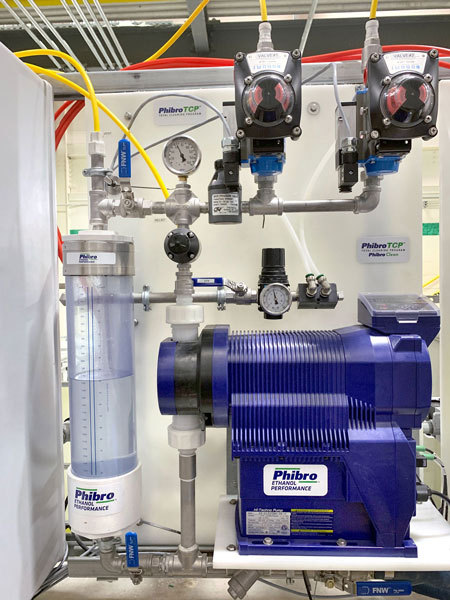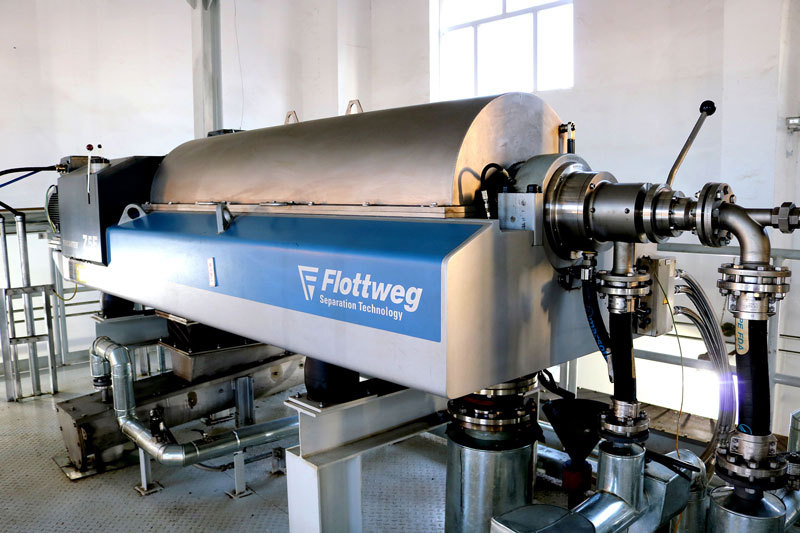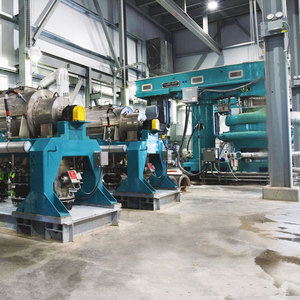More Ways to Max Out DCO




PHOTO: FLUID QUIP
July 20, 2022
BY Katie Schroeder
Distillers corn oil prices have steadily risen in recent years, leading to sustained interest in maximizing DCO recovery. In late April, Fluid Quip Technologies LLC (FQT) announced the potentially game-changing effectiveness of its DCO Technology, getting up to 1.4 pounds of DCO, or “renewable corn oil”—per bushel of corn. FQT has achieved these results at Green Plains’ Wood River, Nebraska, biorefinery, which has fully integrated DCO Technology into the plant’s Maximum Stillage Coproduct (MSC) system. “It’s all about the oil right now,” says Keith Jakel, FQT’s director of sales and marketing. Whether it be through the utilization of groundbreaking technology or an evaluation of obstacles that could be getting in the way of renewable corn oil recovery, producers are searching for ways to recover the most oil out of every corn kernel.
FQT’s development process has benefitted from its relationship with Green Plains, allowing the company to expand and accelerate testing to optimize the technology. “We’re able to do this now on a regular basis; we’re able to take existing technologies and look at different ways of utilizing them,” Jakel says. Having Green Plains’ fleet of biorefineries supporting product innovation means FQT can roll out new products that are “market ready” instead of having to find plants to conduct trials.
Oil Opportunities
In May, renewable corn oil prices averaged above 80 cents per pound, hitting 86 cents in Iowa, according to the USDA Daily Ethanol Report. These high prices are driving producers to look for ways to maximize their DCO production—and giving them a way to pay for it. “The higher the value that a product goes, the more capital is going to be put towards recovering that valuable coproduct,” Jakel says, explaining the value proposition of enhanced DCO extraction. He says corn oil had, and still has, value when retained in distillers grains but picks up considerably more value when separated from whole stillage to be marketed as a feed supplement or a feedstock for other renewable fuels.
Bill Griffiths, industry manager with Flottweg, compares the evolution of corn utilization to the development of the oil industry. “At first, before cars were really a thing, they just wanted to get the kerosene out to light up lamps,” Griffiths says. At this time gasoline was seen as a low value byproduct, but with the invention of the internal combustion engine all of that changed. The corn kernel is going down a similar path, he explains, starting with fuel and feed. “We realized we could take that starch, turn it into ethanol, but everything left was still food for livestock,” Griffiths says, explaining how producers started tapping into DCO 10 to 15 years ago, giving them a valuable new product just when they really needed it. “Corn oil was a big one because, especially [during that period], it was a difficult time economically and the ability to extract value was critical for a lot of plants staying afloat,” he explains.
Balanced Maximization
Producers have to navigate many issues when maximizing renewable corn oil recovery. The balance of an ethanol plant may be upset by tweaking process streams, which can have unintended consequences. “I would say that differing fat content and process upsets are probably the two biggest ones,” Griffiths says. Each corn crop may have different oil content, which plants need to adjust to. Griffiths also emphasizes the importance of uptime in DCO recovery equipment, whether it be a vertical centrifuge or a horizontal machine.
Pedro Peña, lab and R&D director with CTE Global, explains that losing oil to the wet cake is another frequent hurdle to DCO maximization. “I would say the most common [area loss is the] decanter operation,” he says. “If it is leaving [the oil] with the wet cake, we can’t get that back, that’s gone.” Adjustments to decanter operation are a practical step that can make a difference in DCO recovery.
‘Game-Changing’ Technology
FQT developed its DCO Technology out of its MSC platform. The company was already able to achieve a pound or more of corn oil using MSC—due to its advanced fiber washing techniques—but they knew more was possible. Jakel says FQT developed the enhanced DCO platform by leveraging the many control points in its MSC technology to figure out which parts of the washing process could be used to maximize oil production and separate those components.
DCO Technology takes the whole stillage through two stages of screen separation to wash the oil from the fiber fraction in the stillage. Liquid from the fiber washing steps is sent to a final separation step to separate free oil from residual solids to produce an evaporator feed high in oil and low in suspended solids.
Jakel explains that DCO Technology also provides producers the benefit of getting the high value coproduct of renewable corn oil while giving them an opportunity to move toward MSC. The current high prices for corn oil could allow producers to earn back the investment in two years.
The introduction of DCO Technology has received a strong response from producers. “We’re having meetings every week with clients, so the industry itself is interested because they want oil,” Jakel says. He explains that the technology also provides producers with added benefits. “These benefits could include a potential decrease in unfermented solids out of the backset, organic acid reduction, lower suspended solids and energy savings.”
Plant Procedures
It is important to pursue a holistic approach to corn oil maximization throughout the plant. “You know what impacts corn oil production? Everything,” says Dave Fowlie, product manager for process aids with Phibro. Phibro provides clean-in-place and foulant prevention technologies which aid in oil recovery by improving operational performance and run time of the plant as a whole, including corn oil recovery systems and evaporators. “If a plant can significantly reduce the rate of fouling from happening in the first place, equipment can run for longer periods of time between cleaning events,” Fowlie says. “Instead of shutting systems down to clean more often, reducing the rate and degree of foulant buildup allows operations to maintain optimized operating parameters for extended periods of time. This allows for more operating time and less down time to CIP equipment like evaporators and corn oil recovery systems.”
Phibro’s foulant prevention products include PhibroDC, which controls organic deposit buildup, and PhibroSI, which controls inorganic scaling throughout the plant. Their PhibroTCP clean-in-place products include PhibroAC, an acid plus detergent CIP concentrate, and PhibroClean, which is applied in the process condensate rinse cycle to remove deposits more efficiently prior to CIP. Fowlie explains that Phibro also provides technical support including data analytics to help customers optimize foulant prevention and CIP strategies to positively impact corn oil recovery. “Everything from optimizing fermentation kinetics to improving evaporator efficiencies, allowing plants to run better and longer between CIP events while adopting effective and efficient CIP strategies creates an operational environment that has a significant positive impact on corn oil production.,” Fowlie says.
Measurement of DCO is a simple way to examine the quality of the oil and see if it fits your plant’s goals. “'You can’t improve what you can’t measure’ is what I would say,” Griffiths says. “So, making sure the measurement tools that are available are sufficient for what you’re trying to accomplish with maximizing your recovery.” Checking the oil for color and consistency is important since it allows producers to make sure that they are producing oil which is suited for their market. Griffiths explains that producers who are selling the oil into a renewable diesel or biodiesel market need their oil to be without impurities, however a producer selling the oil as a feed component may want some germ particles in the oil. “It depends on who the plant is selling to and what the goals are,” he says.
Oil optimization studies allow plants to identify parts of the ethanol process that are not working as efficiently as possible. “It could be something as simple as adding a heat-and-hold system to make sure that the oil is available for them to be able to recover,” Jakel says. FQT offers oil optimization studies to help plants determine where they might be able to improve plant efficiency while also recovering more oil. “We utilize our knowledge of dry mill and wet mill operations and look at where you can get added benefits—no matter how small,” Jakel says. “We compile the information into a report which outlines what is working, not working and recommended changes, with project cost and ROI projections.”
CTE Global takes a three-pronged approach to helping its customers maximize corn oil recovery, including enzymatic strategies, operational audits and analytical testing. “We’re committed to take advantage of this great opportunity with the demand for corn oil, whether it’s for biodiesel [or] renewable diesel,” Peña says. The first prong of enzymatic strategies utilize the implementation of a protease portfolio into the liquefaction and fermentation to break up the protein matrix, freeing up the oil. The proteases also have an impact of improving the yeast health. “That’s one of the things on the enzymatic strategy, under that same umbrella we also have advanced heavy cellulases and cellulases that break up that fiber matrix and then that opens up the oil as well for downstream extraction,” he says.
The second prong of the approach, operational audits, “leaves no stone unturned” in examining the plant’s operations, examining decanter operations, tricanter separation and more. This process usually takes anywhere from a couple of days to a week, depending on the plant. They are launching their third prong, analytical testing, this summer. Peña explains that analytical testing allows them to track the oil to make sure that their efforts are effective, and the oil is going to the right place. “By taking examples of each of those streams and testing for oil content we can follow where the oil is going through the back end,” Peña says. “If we see enough opportunity for improvement, our operational team is there to make the right changes to make that happen, to make that into a reality.” These different strategies give CTE Global an opportunity to maximize oil recovery by looking for ways to improve efficiency. “It can’t just be one thing, it has to be, you know, a combination of things, it has to be no stone unturned,” Peña says.
Optimizing oil recovery may look a little different for each ethanol plant, but high oil prices could make an investment in new technology or a plant optimization study well worth the cost.
Author: Katie Schroeder
Contact: katie.schroeder@bbiinternational.com
Advertisement
Advertisement
Advertisement
Advertisement
Related Stories
The U.S. exported 31,160.5 metric tons of biodiesel and biodiesel blends of B30 and greater in May, according to data released by the USDA Foreign Agricultural Service on July 3. Biodiesel imports were 2,226.2 metric tons for the month.
The USDA’s Risk Management Agency is implementing multiple changes to the Camelina pilot insurance program for the 2026 and succeeding crop years. The changes will expand coverage options and provide greater flexibility for producers.
EcoCeres Inc. has signed a multi-year agreement to supply British Airways with sustainable aviation fuel (SAF). The fuel will be produced from 100% waste-based biomass feedstock, such as used cooking oil (UCO).
CARB on June 27 announced amendments to the state’s LCFS regulations will take effect beginning on July 1. The amended regulations were approved by the agency in November 2024, but implementation was delayed due to regulatory clarity issues.
SAF Magazine and the Commercial Aviation Alternative Fuels Initiative announced the preliminary agenda for the North American SAF Conference and Expo, being held Sept. 22-24 at the Minneapolis Convention Center in Minneapolis, Minnesota.
Upcoming Events










